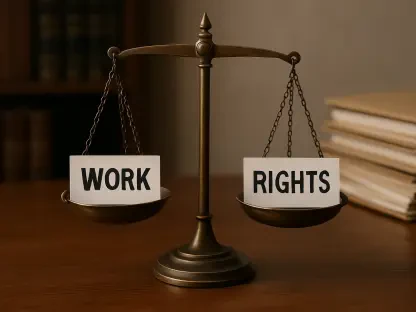In the heart of corporate America, a quiet transformation is unfolding as over half of the S&P 100 companies have shifted how they communicate diversity, equity, and inclusion (DEI) initiatives in their annual filings this year. This shift is accompanied by a staggering 68% drop in the use of the term “DEI” among S&P 500 firms, raising a critical question: are these titans of industry stepping back from their commitments, or are they crafting a new way to champion diversity amid mounting challenges? The answer lies in a complex web of legal, political, and social pressures reshaping the corporate landscape.
The significance of this shift cannot be overstated. DEI programs have long been a cornerstone of corporate responsibility, promising equitable workplaces and reflecting societal values. Yet, as backlash intensifies and new policies emerge, companies are reevaluating how—or even if—they publicly stand behind these initiatives. This story matters because it touches on the future of workplace culture, employee trust, and global business standards. What follows is an exploration of why this change is happening, how strategies are evolving, and what it means for the road ahead.
Why Are Companies Altering DEI Messaging?
A striking trend has emerged in boardrooms across the nation: corporate language around DEI is undergoing a major overhaul. Data reveals that more than half of S&P 100 firms have revised their DEI messaging in securities filings this year compared to last. The sharp 68% decline in mentioning “DEI” among S&P 500 companies signals a deliberate move toward less explicit terminology, hinting at a broader caution in public statements.
This change isn’t merely cosmetic. It reflects a calculated response to an environment where DEI has become a lightning rod for controversy. Companies appear to be distancing themselves from overt declarations, possibly to avoid drawing unwanted attention from critics or legal challenges. The numbers paint a clear picture—21% of S&P 500 firms have reduced or entirely removed DEI metrics and targets from their disclosures, suggesting a retreat from transparency.
Beyond the statistics, there’s a palpable tension in how firms navigate this space. The decision to soften language often stems from a desire to maintain focus on core business goals while still addressing diversity internally. This balancing act sets the stage for understanding the external forces pushing companies toward such discretion.
What Forces Are Shaping DEI in the Corporate World?
The current climate for DEI in corporate America is marked by unprecedented challenges. A landmark Supreme Court ruling in 2023 against affirmative action in higher education sent ripples through the private sector, raising questions about the legality of diversity programs. Coupled with political shifts, including a January executive order targeting private sector DEI, the stakes for companies have escalated significantly.
Social scrutiny adds another layer of complexity. Public opinion on DEI is deeply divided, with some viewing it as essential for fairness and others as a form of overreach. This polarization forces corporations to tread carefully, as missteps can alienate employees, investors, or customers. Multinational firms, in particular, face pressure to align with global expectations while managing domestic backlash.
These combined legal, political, and societal dynamics create a high-stakes environment. Companies must weigh the risks of maintaining visible DEI commitments against the potential fallout of appearing to abandon them. This tension drives the strategic shifts now evident in corporate policies and public-facing narratives.
How Are Major Firms Adjusting Their DEI Approaches?
Concrete changes in DEI strategies among major U.S. firms reveal a pattern of calculated adaptation. Public disclosures have notably declined, with S&P 500 companies reporting data on women in management dropping from 71.2% last year to 55.1% this year. Similarly, board diversity metrics, such as female board member data, fell from 90.5% to 60.4%, indicating a pullback from specific diversity reporting.
Another pivot is evident in executive compensation structures. Previously, 68% of S&P 500 companies tied pay to DEI goals; that figure has now plummeted to 35.3%. Instead, firms are linking compensation to broader human capital themes like talent development, a shift that dilutes the focus on explicit diversity targets while still addressing related priorities. This trend suggests a move toward integration over spotlighting.
Quietly, however, internal governance is being strengthened. Board oversight of DEI has risen to 79% among S&P 500 firms, up from 72% last year, showing a commitment to accountability behind closed doors. Real-world examples, such as McDonald’s and Target adjusting their DEI policies, underscore this discreet yet persistent focus, highlighting a strategy of resilience amid public caution.
What Do Experts Say About This Corporate Shift?
Insights from thought leaders provide clarity on these evolving trends. Andrew Jones, principal researcher at The Conference Board, argues that reduced public disclosure does not equate to abandonment. “Companies are reframing DEI commitments strategically, embedding them into broader frameworks to sustain progress without the spotlight,” Jones notes, emphasizing a nuanced approach over outright retreat.
Data supports this perspective, though challenges remain. A report indicates that 20% of companies scrapped DEI programs following recent political shifts, reflecting the intense pressure some face. Meanwhile, multinational corporations grapple with balancing domestic criticism against global demands for diversity transparency, creating a tightrope walk for leadership teams.
These expert views and real-world tensions reveal a corporate reality of adaptation under strain. Firms are not uniformly stepping away from DEI but are instead finding ways to protect initiatives from external threats. This duality—public caution paired with internal resolve—defines the current corporate response to a hostile climate.
How Can Companies Sustain DEI in Challenging Times?
Navigating the future of DEI requires practical, actionable strategies. One approach is to integrate DEI into wider human capital frameworks, such as employee engagement or talent development programs. This method allows companies to maintain focus on diversity without attracting undue scrutiny, ensuring efforts continue under a less controversial banner.
Strengthening internal oversight offers another path forward. With board committee oversight of DEI reaching 86.8% among Russell 3000 companies this year, firms can ensure accountability without public fanfare. This behind-the-scenes commitment helps safeguard initiatives against external challenges while maintaining corporate integrity.
For multinational entities, aligning with global standards is critical. Adhering to frameworks like the EU’s Corporate Sustainability Reporting Directive ensures consistent diversity reporting, even if scaled back domestically. These steps—integration, governance, and global alignment—provide a roadmap for sustaining DEI, offering resilience in an uncertain landscape.
Reflecting on the Path Forward
Looking back, the journey of DEI in corporate America has been one of adaptation under intense scrutiny. Major companies have faced a gauntlet of legal rulings, political shifts, and social divides, prompting a strategic retreat from public declarations while bolstering internal commitments. The story of this transformation is not one of surrender but of recalibration in the face of adversity.
Moving ahead, stakeholders must consider how to foster environments where diversity thrives without becoming a battleground. Companies should prioritize transparent dialogue with employees to rebuild trust, ensuring internal policies reflect genuine intent. Additionally, tracking global benchmarks can help balance domestic constraints with international expectations. The challenge now lies in sustaining progress discreetly yet decisively, ensuring that the essence of equity and inclusion endures through turbulent times.









